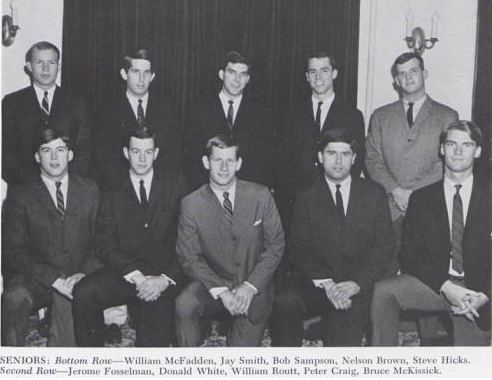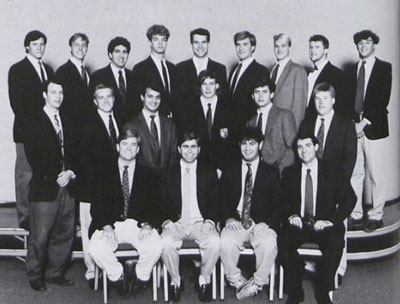
Mission & Vision
Each entity of Sigma Alpha Epsilon operates under its own mission, and each board of directors maintains that mission through a vision or plan.
The mission of Sigma Alpha Epsilon is to promote the highest standards of friendship, scholarship, and service for our members based upon the ideals set forth by our Founders and as specifically enunciated in our creed, “The True Gentleman.”
The True Gentleman is the man whose conduct proceeds from good will and an acute sense of propriety, and whose self-control is equal to all emergencies; who does not make the poor man conscious of his poverty, the obscure man of his obscurity, or any man of his inferiority or deformity; who is himself humbled if necessity compels him to humble another; who does not flatter wealth, cringe before power, or boast of his own possessions or achievements; who speaks with frankness but always with sincerity and sympathy; whose deed follows his word; who thinks of the rights and feelings of others, rather than his own; and who appears well in any company, a man with whom honor is sacred and virtue safe.
Chapter History
The founding of Pennsylvania Alpha-Zeta was initiated through the collaboration of Brothers H.H Cowan of Michigan Alpha, George H. Bunting of Tennessee Zeta and Stanley M. Rinehart of Michigan Alpha. Cowan negotiated with George L.W. Price of Pittsburgh who attended Pennsylvania State College and together they pledged eight good men at Bellefonte, PA., where the first meeting was held in the Bush House of May 13, 1892. H.H. Cowan, editor of the Record, was the presiding officer while Stanley Rinehart acted as Eminent Recorder.

On June 10, 1892 J.M. Vastine became the first pledge of the new chapter. Within days he was made a member of the brotherhood and subsequently elected to positions of authority in the chapter. At least for the first four years, pledging was essentially non-existent. Brotherhood was usually attained within a week of accepting the bid along with immediate occupancy of fraternity quarters.
The story of the present house actually begins in June 1906 when the newly formed house association was legally incorporated at Bellefonte. A building fund drive was begun and each brother was obligated to pay $100.00 house association fee in installments of ten dollars each term. In 1907 our present lot was purchased from professor Osmond at a cost of $7,500 by Brother P.B Brenneman. In choosing the lot several items were considered and in retrospect we can deem this decision a wise one. The lot was seen as being located in the most desirable part of town, located in the heart of what was then “fraternity row.” It was “the most desirable view in town” with the advantage of large trees already established on the lot.
Directly in front was “a grand view of Old Main,” the campus, the campus fraternities and the Nittany Mountains. In the words of an unknown brother, “Our home among these beautiful trees brings us to mind the old environments of State with its Charm and its Romance and offers to Sigma Alpha Epsilon of the future a place of surpassing beauty and transcendent inspiration.
The chapter led by some of the most able leaders on campus won National’s John Q. Mosely Award for Fraternity Zeal in 1970 and became the only chapter to win the award twice by recapturing this coveted honor in 1978; Eminent Archon Bruce Roland and Jeffrey Vincent Hembrock led the chapter respectfully. On April 9, 1992, members of Pennsylvania Alpha-Zeta gathered to celebrate a century’s worth of pride and excellence. The “Centennial Celebration” was only possible through the efforts of B. Robert Bickhart ’78 and B. Christopher Colburn ’94. The dinner program consisted of speeches given by Eminent Archon Joseph Naggar ’92 and Eminent Supreme Archon William Chapman ’58 (Oklahoma State University).
National History
Sigma Alpha Epsilon was founded on March 9, 1856, at the University of Alabama in Tuscaloosa, Alabama. Its founders were Noble Leslie Devotie, Nathan Elams Cockrell, John Barratt Rudulph, John Webb Kerr, Samuel Marion Dennis, Wade Hampton Foster, Abner Edwin Patton, and Thomas Chappell Cook. Their leader was DeVotie, who wrote the ritual, created the grip, and chose the name. Rudulph designed the badge. Of all existing national social fraternities today, Sigma Alpha Epsilon is the only one founded in the antebellum South.
Founded in a time of intense sectional feeling, Sigma Alpha Epsilon confined its growth to the southern states. By the end of 1857, the fraternity numbered seven chapters. Its first national convention met in the summer of 1858 at Nashville, Tennessee, with four of its eight chapters in attendance. By the time of the outbreak of the American Civil War in 1861, fifteen chapters had been established.
None of the founders of SAE were members of any other fraternity, though Noble Leslie Devotie had been invited to join all the other fraternities at the University of Alabama before founding Sigma Alpha Epsilon. The fraternity had fewer than 400 members when the Civil War began. Of those, 369 went to war for the Confederate States. Seventy-four members of the fraternity, including Noble DeVotie, lost their lives in the war. DeVotie, who served as a Chaplain in the Confederate Army, is noted as the first Alabama soldier to lose his life in the “War of Rebellion.” After the Civil War, only one chapter survived – at tiny Columbian College (which is now George Washington University) in Washington, D.C..
When a few of the young veterans returned to the Georgia Military Institute and found their college burned to the ground, they decided to enter the University of Georgia in Athens, Georgia. The founding of a chapter there at the end of 1865, along with the re-establishment of the chapter at the University of Virginia, led to the fraternity’s revival. Soon, other chapters came back to life and, in 1867, the first post-war convention was held at Nashville, Tennessee, where a half-dozen revived chapters planned the fraternity’s future growth.
In the 1870s and early 1880s, more than a score of new chapters were formed. Older chapters died as fast as new ones were established. By 1886, the fraternity had chartered 49 chapters, but few were active. The first northern chapter had been established at Pennsylvania College (now Gettysburg College), in 1883, and a second was placed at Mount Union College in Ohio two years later.
Soon after, 16-year-old Harry Bunting entered Southwestern Presbyterian University in Clarksville, Tennessee, now known as Rhodes College in Memphis, Tennessee. He was initiated into the Tennessee Zeta Chapter, which had previously initiated two of his brothers. In just eight years, Harry Bunting and his younger brother, George, emboldened Sigma Alpha Epsilon chapters to increase their membership. They wrote encouraging articles in the fraternity’s quarterly journal, The Record, promoting better chapter standards. Above all, they gave new life to old chapters in the South (including the mother chapter at Alabama) and founded new ones in the North and West.

The Buntings were responsible for an explosion of growth, founding nearly 50 chapters of Sigma Alpha Epsilon. When Harry Bunting founded the Northwestern University chapter in 1894, he initiated as a charter member William Collin “Billy” Levere. Bunting passed the torch of leadership to Levere, and for the next three decades, Levere’s high spirits brought the fraternity to maturity.
When Levere died on February 22, 1927, the fraternity’s Supreme Council decided to name the new national headquarters building The Levere Memorial Temple. Construction of the Temple, an immense German Gothic structure located near Lake Michigan and across from the Northwestern University campus, was started in 1929, and the building was dedicated in the winter of 1930.
When the Supreme Council met regularly in the early 1930s at the Temple, educator John O. Moseley, the fraternity’s national president, lamented, “We have in the Temple a magnificent school-house. Why can we not have a school?” Accordingly, the economic depression notwithstanding, the fraternity’s first Leadership School was held under the direction of Moseley in the summer of 1935. In the last years of Moseley’s life, he served the fraternity as its executive secretary, capping an academic career that included two college presidencies.

The True Gentleman is the creed of Sigma Alpha Epsilon, which was first adopted by the fraternity sometime in the 1930s. However, it wasn’t until the 2001 Fraternity Convention in Orlando, Florida that it was officially adopted as the organization’s creed. The definition was discovered by Judge Walter B. Jones, who first came upon it in an Alabama Baptist quarterly of which he was the editor. He sent a copy of it to John O. Moseley, the leader of the annual Leadership Schools, who was quite taken with it. Moseley began using it at the schools. For many years, the author of it was thought to be anonymous until the 1970s when the editor of the Sigma Alpha Epsilon pledge manual, The Phoenix, Joseph Walt, discovered that the U.S. Naval Academy in Annapolis also used it in a manual. The author was denoted there as one John Walter Wayland. “The True Gentleman” had actually first appeared in The Baltimore Sun as part of a competition for the best definition of a true gentleman with Wayland’s submission being crowned the winner.
Founding Fathers
Noble Leslie DeVotie
John Barratt Rudulph
Nathan Elams Cockrell
John Webb Kerr
Wade Foster
Samuel Marion Dennis
Abner Edwin Patton
Thomas Chappell Cook
